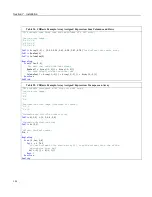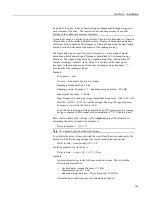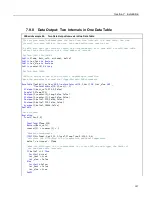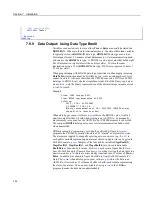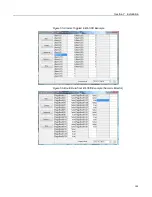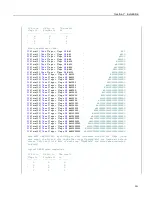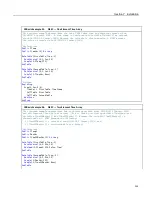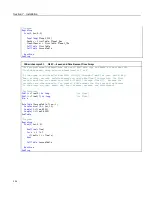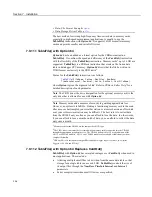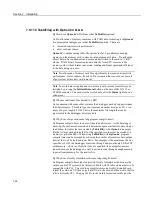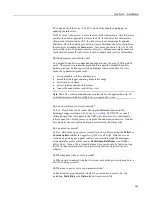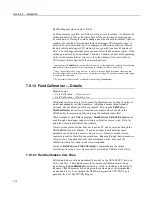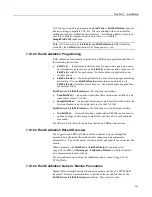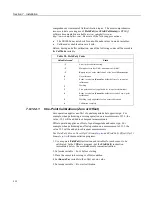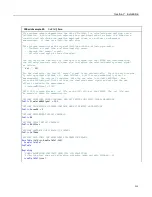
Section 7. Installation
FlagsBool8(1) = Flags
AND
&HFF
'AND 1st 8 bits of "Flags" & 11111111
FlagsBool8(2) = (Flags
>>
8)
AND
&HFF
'AND 2nd 8 bits of "Flags" & 11111111
FlagsBool8(3) = (Flags
>>
16)
AND
&HFF
'AND 3rd 8 bits of "Flags" & 11111111
FlagsBool8(4) = (Flags
>>
24)
AND
&HFF
'AND 4th 8 bits of "Flags" & 11111111
CallTable
(Bool8Data)
NextScan
EndProg
7.9.10 Data Output: Using Data Type NSEC
Data of NSEC type reside only in final-data memory. A datum of NSEC consists
of eight bytes — four bytes of seconds since 1990 and four bytes of nanoseconds
into the second.
Nsec
is declared in the
Data Type
parameter in
final-data
memory output-processing instructions
(p. 542).
It is used in the following
applications:
•
Placing a time stamp in a second position in a record.
•
Accessing a time stamp from a data table and subsequently storing it as part
of a larger data table.
Maximum()
,
Minimum()
, and
FileTime()
instructions
produce a time stamp that may be accessed from the program after being
written to a data table. The time of other events, such as alarms, can be stored
using the
RealTime()
instruction.
•
Accessing and storing a time stamp from another datalogger in a PakBus
network.
7.9.10.1 NSEC Options
NSEC is used in a CRBasic program one of the following ways. In all cases, the
time variable is only sampled with a
Sample()
instruction,
Reps
=
1
.
1. Time variable is declared
As Long.
Sample()
instruction assumes the time
variable holds seconds since 1990 and microseconds into the second is 0. The
value stored in final-data memory is a standard time stamp. See CRBasic
example
NSEC — One Element Time Array
(p. 202).
2. Time-variable array dimensioned to (2) and
As Long
—
Sample()
instruction
assumes the first time variable array element holds seconds since 1990 and the
second element holds microseconds into the second. See CRBasic example
NSEC — Two Element Time Array
(p. 203).
3. Time-variable array dimensioned to (7) or (9) and
As Long
or
As Float
—
Sample()
instruction assumes data are stored in the variable array in the
sequence year, month, day of year, hour, minutes, seconds, and milliseconds.
See CRBasic example
NSEC — Seven and Nine Element Time Arrays
(p. 204).
CRBasic example
NSEC — Convert Time Stamp to Universal Time
(p. 202)
shows
one of several practical uses of the NSEC data type.
202
Summary of Contents for CR1000
Page 2: ......
Page 4: ......
Page 6: ......
Page 32: ......
Page 36: ......
Page 38: ......
Page 40: ......
Page 60: ...Section 4 System Quickstart Figure 16 PC200W View Line Graph 60 ...
Page 96: ......
Page 98: ...98 ...
Page 302: ......
Page 453: ...Section 8 Operation Figure 115 Using the Keyboard Display 453 ...
Page 456: ...Section 8 Operation Figure 118 Real Time Custom 456 ...
Page 457: ...Section 8 Operation 8 8 1 3 Final Memory Tables Figure 119 Final Memory Tables 457 ...
Page 458: ...Section 8 Operation 8 8 2 Run Stop Program Figure 120 Run Stop Program 458 ...
Page 460: ...Section 8 Operation Figure 122 File Edit 460 ...
Page 461: ...Section 8 Operation 8 8 4 PCCard Memory Card Display Figure 123 PCCard CF Card Display 461 ...
Page 478: ......
Page 506: ......
Page 536: ......
Page 636: ......
Page 642: ......
Page 644: ......
Page 676: ......
Page 677: ......



